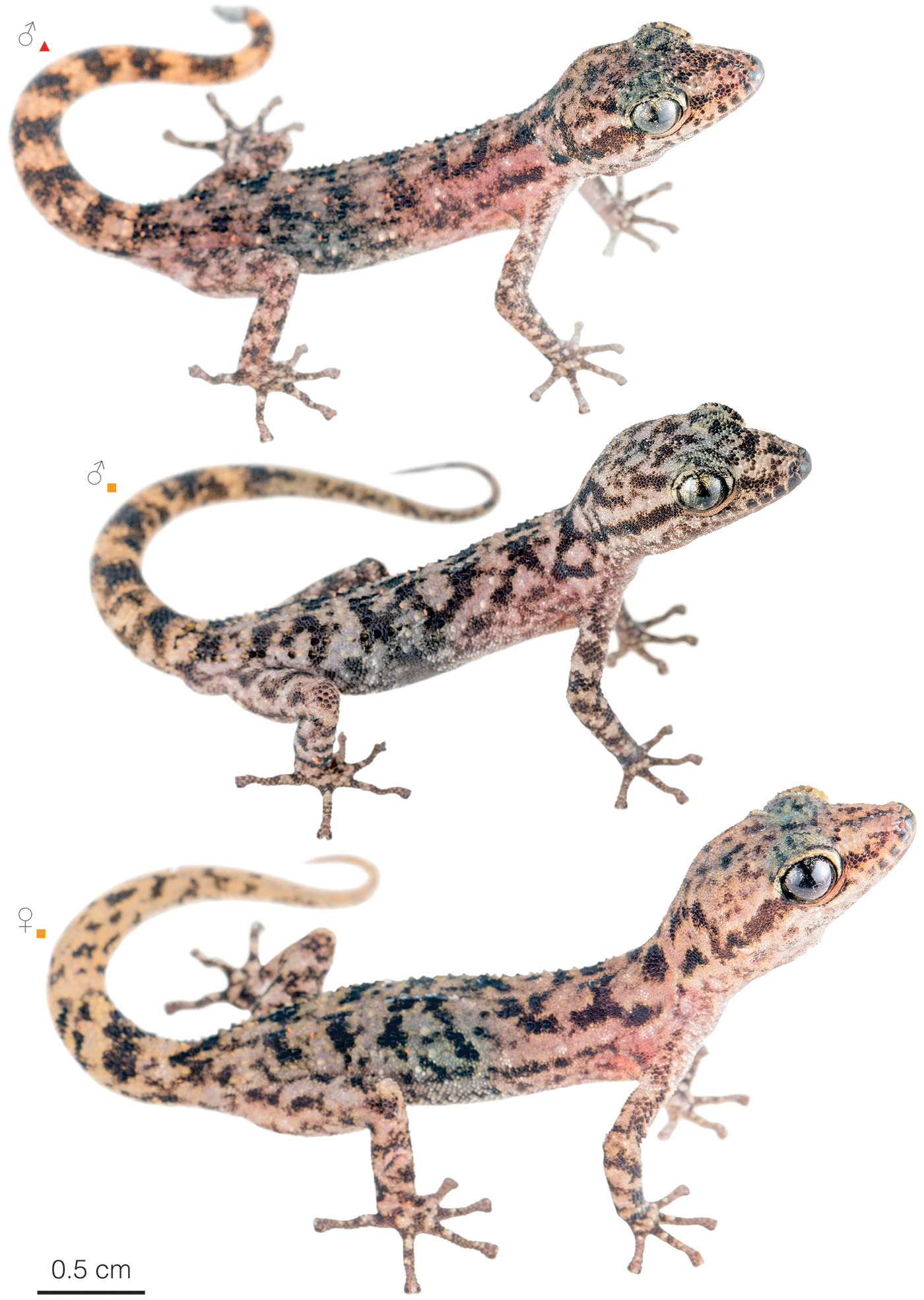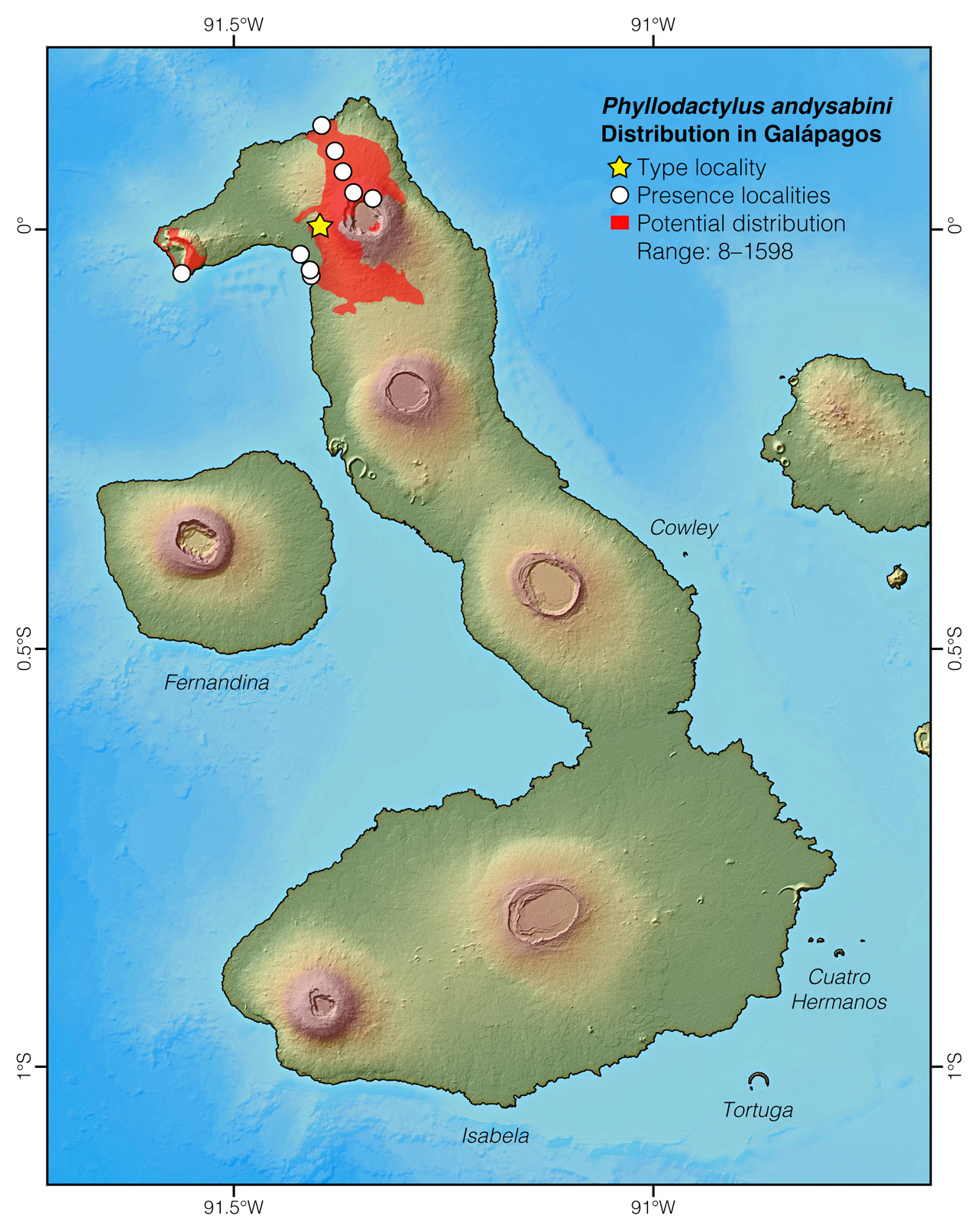Published October 10, 2019. Updated December 20, 2023. Open access. Peer-reviewed. | Purchase book ❯ |
Andy Sabin’s Leaf-toed Gecko (Phyllodactylus andysabini)
Reptiles of Ecuador | Sauria | Phyllodactylidae | Phyllodactylus andysabini
English common name: Andy Sabin’s Leaf-toed Gecko.
Spanish common name: Geco de Andy Sabin.
Recognition: ♂♂ 7.8 cmMaximum distance from the snout to the tip of the tail. Snout–vent length=3.9 cm. ♀♀ 8.0 cmMaximum distance from the snout to the tip of the tail..1 Phyllodactylus andysabini is easily distinguishable from other lizards occurring on northern Isabela Island (that is, iguanas and lava lizards) by its nocturnal habits, vertical pupils, and fingertips lacking visible claws.1 As of 2023, this is the only gecko known to occur on and around Wolf Volcano. The dorsal coloration is usually pale grayish brown with irregular dark blotches and scattered white tubercles (Fig. 1). This species occurs north of the known distribution of P. simpsoni, from which it differs by having supranasals not in contact and by having the throat densely stippled with dark brown pigment (usually immaculate in P. simpsoni).1

Figure 1: Individuals of Phyllodactylus andysabini from Piedras Blancas () and slopes of Wolf Volcano (), Isabela Island, Galápagos, Ecuador.
Natural history: Phyllodactylus andysabini is a nocturnal and mostly terrestrial gecko that occurs in comparatively low densities in the deciduous forests, dry shrublands, and dry grasslands of Wolf Volcano. Andy Sabin’s Leaf-toed Geckos have been seen foraging at ground level or on rocks, tree trunks, and branches up to 40 cm above the ground.1 Eggs of this species have been found in holes up to 3 m above the ground in mangrove trees growing on the beach.2 When threatened, these shy geckos flee into crevices or under tree bark. If captured, they may shed the tail. Potential, but unconfirmed, predators include housecats and rats.
Conservation: Endangered Considered to be facing a high risk of extinction in the near future..1 Phyllodactylus andysabini is listed in this category following IUCN criteria3 because the species’ area of occupancy is estimated to be smaller than 250 km2, its habitat is fragmented by lava flows, and, although there is no information on population trends, there is an ongoing threat of decline in the number of mature individuals due to predation by introduced species (cats and black rats).1 Alien predators are believed to have decimated the populations of other geckos on the Galápagos. Volcanic eruptions are also a serious threat to P. andysabini. Wolf Volcano is in constant activity, with its last eruption recorded in May 2015.1
Distribution: Phyllodactylus andysabini is endemic to an area of approximately 250 km2 in northern Isabela Island, particularly around the western and northern slopes of Wolf Volcano, Galápagos, Ecuador (Fig. 2).

Figure 2: Distribution of Phyllodactylus andysabini in Galápagos. The star corresponds to the type locality: western slope of Wolf Volcano. See Appendix 1 for a complete list of the presence localities included in the map.
Etymology: The generic name Phyllodactylus comes from the Greek words phyllon (=leaf) and daktylos (=finger),4 and refers to the leaf-shaped fingers characteristic of this group of geckos. The specific name andysabini honors American philanthropist and conservationist Andrew “Andy” Sabin, known also as “Mr. Salamander,” in recognition of his life-long support of environmental programs around the world and for his passion for the preservation of amphibians and reptiles. In addition to providing financial support, both personally and through the Andrew Sabin Family Foundation to hundreds of organizations, Andy is directly involved in conservation and field research. He has effectively protected over 264,365 acres of habitat and also participates in expeditions to remote places across the globe in search of new species.1
See it in the wild: Individuals of Phyllodactylus andysabini occur on and around Wolf Volcano, which is inaccessible to tourism. Researchers and members of the Galápagos National Park may visit the habitat of P. andysabini, but only in the context of a scientific expedition or a conservation agenda.
Author: Alejandro ArteagaaAffiliation: Fundación Khamai, Reserva Arlequín, Ecoruta Paseo del Quinde km 56, Santa Rosa de Mindo, Pichincha 171202, Ecuador.
Academic reviewers: Miguel Vences,bAffiliation: Technische Universität Braunschweig, Braunschweig, Germany. Alex Pyron,cAffiliation: George Washington University, Washington, D.C., USA. and Claudia KochdAffiliation: Zoologisches Forschungsmuseum Alexander Koenig, Bonn, Germany.
Photographer: Jose VieiraeAffiliation: Tropical Herping (TH), Quito, Ecuador.,fAffiliation: ExSitu, Quito, Ecuador.
How to cite? Arteaga A (2023) Andy Sabin’s Leaf-toed Gecko (Phyllodactylus andysabini). In: Arteaga A, Bustamante L, Vieira J (Eds) Reptiles of Ecuador: Life in the middle of the world. Available from: www.reptilesofecuador.com. DOI: 10.47051/KKFT1847
Literature cited:
- Arteaga A, Bustamante L, Vieira J, Tapia W, Carrión J, Guayasamin JM (2019) Two new species of leaf-toed geckos (Phyllodactylus) from Isabela Island, Galápagos Archipelago, Ecuador. In: Arteaga A, Bustamante L, Vieira J, Tapia W, Guayasamin JM (Eds) Reptiles of the Galápagos: Life on the Enchanted Islands. Tropical Herping, Quito, 174–187.
- Van Denburgh J (1912) Expedition of the California Academy of Sciences to the Galápagos Islands, 1905-1906. VI. The geckos of the Galápagos Archipelago. Proceedings of the California Academy of Sciences 1: 405–430.
- IUCN (2012) IUCN Red List categories and criteria: Version 3.1. Second edition. IUCN Species Survival Commission, Gland and Cambridge, 32 pp.
- Brown RW (1956) Composition of scientific words. Smithsonian Books, Washington, 882 pp.
Appendix 1: Locality data used to create the distribution map of Phyllodactylus andysabini in Ecuador (Fig. 2). Go to the section on symbols and abbreviations for a list of acronyms used. Asterisk (*) indicates type locality.
| Country | Province | Locality | Source |
| Ecuador | Galápagos | Banks Bay | Van Denburgh 1912 |
| Ecuador | Galápagos | Northern rim of Wolf Volcano | iNaturalist; photo examined |
| Ecuador | Galápagos | Puerto Bravo | Arteaga et al. 2019 |
| Ecuador | Galápagos | Punta Vicente Roca | Arteaga et al. 2019 |
| Ecuador | Galápagos | Tomás de Berlanga | iNaturalist; photo examined |
| Ecuador | Galápagos | Volcán Wolf | Arteaga et al. 2019 |
| Ecuador | Galápagos | Western slope of Wolf Volcano* | Arteaga et al. 2019 |
| Ecuador | Galápagos | Wolf Volcano Camp 1 (Piedras Blancas) | Arteaga et al. 2019 |
| Ecuador | Galápagos | Wolf Volcano Camp 2 | Arteaga et al. 2019 |
| Ecuador | Galápagos | Wolf Volcano Camp 3 | Arteaga et al. 2019 |